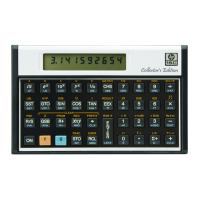Appendix E: A Detailed Look at f 247
Thus, setting the display format to i n or ^ n, where n is an
integer,
*
implies that the uncertainty in the function’s values is
δ(x) = 0.5 × 10
−n
× 10
m(x)
= 0.5 × 10
−n + m(x)
In this formula, n is the number of digits specified in the display format
and m(x) is the exponent of the function’s value at x that would appear if
the value were displayed in i display format.
The uncertainty is proportional to the factor 10
m(x)
, which represents the
magnitude of the function’s value at x. Therefore, i and ^ display
formats imply an uncertainty in the function that is relative to the
function’s magnitude.
Similarly, if a function value is displayed in • n, the rounding of the
display implies that the uncertainty in the function’s values is
δ(x) = 0.5 × 10
−n
.
Since this uncertainty is independent of the function’s magnitude, •
display format implies an uncertainty that is absolute.
Each time the f algorithm samples the function at a value of x, it also
derives a sample of δ(x), the uncertainty of the function’s value at x. This
is calculated using the number of digits n currently specified in the display
format and (if the display format is set to i or ^) the magnitude
m(x) of the function’s value at x. The number Δ, the uncertainty of the
approximation to the desired integral, is the integral δ(x):
*
Although i 8 or 9 generally results in the same display as i 7, it will result in a
smaller uncertainty of a calculated integral. (The same is true for the ^ format.) A
negative value for n (which can be set by using the Index register) will also affect the
uncertainty of an f calculation. The minimum value for n that will affect uncertainty
is −6. A number in R
I
less than −6 will be interpreted as −6.

